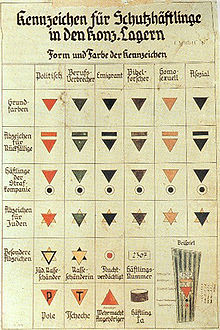Black triangle (badge)
This article is about the Black Triangle as a badge or symbol: for other uses see the disambiguation page Black triangle.


The black triangle is a lesbian or feminist symbol of pride and solidarity.
The symbol originates from Nazi concentration camps, where every prisoner had to wear one of the Nazi concentration camp badges on their jacket, the colour of which categorised them according "their kind". Individuals deemed "asocial" had to wear the black triangle. The majority of black-triangle prisoners were mentally retarded or homeless. But smaller groups of prisoners were also given this badge, including alcoholics, the habitually "work shy", prostitutes, and others.
Roma or gypsies were usually classed with black-triangle prisoners, but at some camps were given a separate badge - the brown triangle - instead.
In the Nazis' meticulous records there is no word of the black triangle having been imposed on lesbians, or of lesbians as a group being confined to concentration camps. However, some have reasoned that since the Nazis believed strongly in a traditional social role for women, lesbians and other sexually unconventional women might logically have been considered "asocial" from the Nazis' point of view.
It is also possible that Playing for Time, a holocaust memoir by Frenchwoman Fania Fénélon, helped create the belief that the black triangle was worn by lesbians. Fénélon's memoir includes lesbian themes, and describes an evening of entertainment in the asocials' barracks as the "Black Triangles' Ball." [1]
Whatever the reason, lesbians have over time claimed the black triangle as a symbol of defiance against repression and discrimination, and it is considered a counterpart to the gay pink triangle. Today, it is as a lesbian symbol that the black triangle is most widely recognized.
Further reading
- A short explanation of the origin of pink and other queer triangles
- Zoe, Lucinda. "The Black Triangle," Lesbian Herstory Archives Newsletter [Brooklyn, N.Y.] No. 12 (June 1991): p. 7.
- A critical discussion of the notion that black triangles were used to mark lesbians in the concentration camps in a manner equivalent to the pink triangle for homosexual men, along with remarks on when the black triangle came to be used as a contemporary lesbian symbol.
